| Revision as of 02:39, 15 June 2024 editGreenC bot (talk | contribs)Bots2,555,770 edits Move 1 url. Wayback Medic 2.5 per WP:URLREQ#angelfire.com← Previous edit | Revision as of 14:05, 29 June 2024 edit undoInsideinfodini (talk | contribs)5 edits Religion.Tags: Reverted Mobile edit Mobile web editNext edit → | ||
| Line 19: | Line 19: | ||
| | movement = | | movement = | ||
| | period = ] and Ghaznavids | | period = ] and Ghaznavids | ||
| {{Infobox religious biography | |||
| |embed=yes | |||
| |religion = ] | |||
| }} | |||
| }} | }} | ||
| ] | ] | ||
Revision as of 14:05, 29 June 2024
Persian poet, author of Shahnameh For places called and other people named Ferdowsi, see Ferdowsi (disambiguation).You can help expand this article with text translated from the corresponding article in Persian. (December 2020) Click for important translation instructions.
|
| Ferdowsi فردوسی | |
|---|---|
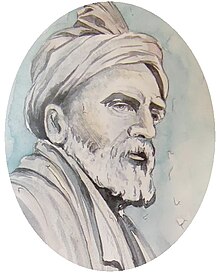 A portrait of Ferdowsi A portrait of Ferdowsi | |
| Native name | Template:Lang-fa |
| Born | 940 Tus, Iran, Samanid Empire |
| Died | 1019 or 1025 (79 or 85 years old) Tus, Iran, Ghaznavid Empire |
| Occupation | Poet |
| Language | Early Modern Persian |
| Period | Samanids and Ghaznavids |
| Religious life | |
| Religion | Islam |
| Genre | Persian poetry, national epic |
| Notable works | Shahnameh |
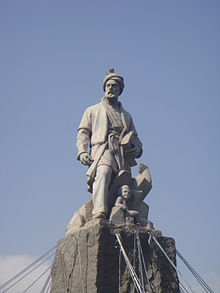

Abul-Qâsem Ferdowsi Tusi (Template:Lang-fa; 940 – 1019/1025), also Firdawsi or Ferdowsi (فردوسی), was a Persian poet and the author of Shahnameh ("Book of Kings"), which is one of the world's longest epic poems created by a single poet, and the greatest epic of Persian-speaking countries. Ferdowsi is celebrated as one of the most influential figures of Persian literature and one of the greatest in the history of literature.
Name
Except for his kunya (ابوالقاسم – Abo'l-Qâsem) and his laqab (فِردَوسی – Ferdowsī, meaning 'paradisic'), nothing is known with any certainty about his full name. From an early period on, he has been referred to by different additional names and titles, the most common one being حکیم / Ḥakīm ("philosopher"). Based on this, his full name is given in Persian sources as حکیم ابوالقاسم فردوسی توسی / Ḥakīm Abo'l-Qâsem Ferdowsī Țusī. Due to the non-standardised transliteration from Persian into English, different spellings of his name are used in English works, including Firdawsi, Firdusi, Firdosi, Firdausi, etc. The Encyclopaedia of Islam uses the spelling Firdawsī, based on the standardised transliteration method of the German Oriental Society. The Encyclopædia Iranica, which uses a modified version of the same method (with a stronger emphasis on Persian intonations), gives the spelling Ferdowsī. In both cases, the -ow and -aw are to be pronounced as a diphthong (), reflecting the early New Persian pronunciation of the name. The modern Tajik transliteration of his name in Tajik Cyrillic is Ҳаким Абулқосим Фирдавсӣ Тӯсӣ (Hakim Abdulqosim Firdavsí Tŭsí).
Life
Family
Ferdowsi was born into a family of Iranian landowners (dehqans) in 940 in the village of Paj, near the city of Tus, in the Khorasan region of the Samanid Empire, which is located in the present-day Razavi Khorasan province of northeastern Iran. Little is known about Ferdowsi's early life. The poet had a wife, who was probably literate and came from the same dehqan class. The dehqans were landowning Iranian aristocrats who had flourished under the Sasanian dynasty (the last pre-Islamic dynasty to rule Iran) and whose power, though diminished, had survived into the Islamic era which followed the Islamic conquests of the 7th century. The dehqans were attached to the pre-Islamic literary heritage, as their status was associated with it (so much so that dehqan is sometimes used as a synonym for "Iranian" in the Shahnameh). Thus they saw it as their task to preserve the pre-Islamic cultural traditions, including tales of legendary kings.
He had a son, who died at the age of 37, and was mourned by the poet in an elegy which he inserted into the Shahnameh.
Background
The Islamic conquests of the 7th century brought gradual linguistic and cultural changes to the Iranian Plateau. By the late 9th century, as the power of the caliphate had weakened, several local dynasties emerged in Greater Iran. Ferdowsi grew up in Tus, a city under the control of one of these dynasties, the Samanids, who claimed descent from the Sassanid general Bahram Chobin (whose story Ferdowsi recounts in one of the later sections of the Shahnameh). The Samanid bureaucracy used the New Persian language, which had been used to bring Islam to the Eastern regions of the Iranian world and supplanted local languages, and commissioned translations of Pahlavi texts into New Persian. Abu Mansur Muhammad, a dehqan and governor of Tus, had ordered his minister Abu Mansur Mamari to invite several local scholars to compile a prose Shahnameh ("Book of Kings"), which was completed in 1010. Although it no longer survives, Ferdowsi used it as one of the sources of his epic. Samanid rulers were patrons of such important Persian poets as Rudaki and Daqiqi, and Ferdowsi followed in the footsteps of these writers.
Details about Ferdowsi's education are lacking. Judging by the Shahnameh, there is no evidence he knew either Arabic or Pahlavi.
Life as a poet
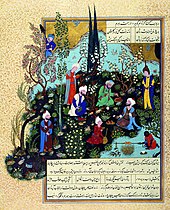
It is possible that Ferdowsi wrote some early poems which have not survived. He began work on the Shahnameh around 977, intending it as a continuation of the work of his fellow poet Daqiqi, who had been assassinated by his slave. Like Daqiqi, Ferdowsi employed the prose Shahnameh of ʿAbd-al-Razzāq as a source. He received generous patronage from the Samanid prince Mansur and completed the first version of the Shahnameh in 994. When the Turkic Ghaznavids overthrew the Samanids in the late 990s, Ferdowsi continued to work on the poem, rewriting sections to praise the Ghaznavid Sultan Mahmud. Mahmud's attitude to Ferdowsi and how well he rewarded the poet are matters which have long been subject to dispute and have formed the basis of legends about the poet and his patron (see below). The Turkic Mahmud may have been less interested in tales from Iranian history than the Samanids. The later sections of the Shahnameh have passages which reveal Ferdowsi's fluctuating moods: in some he complains about old age, poverty, illness and the death of his son; in others, he appears happier. Ferdowsi finally completed his epic on 8 March 1010. Virtually nothing is known with any certainty about the last decade of his life.
Tomb


Ferdowsi was buried in his own garden, burial in the cemetery of Tus having been forbidden by a local cleric. A Ghaznavid governor of Khorasan constructed a mausoleum over the grave and it became a revered site. The tomb, which had fallen into decay, was rebuilt between 1928 and 1934 by the Society for the National Heritage of Iran on the orders of Reza Shah, and has now become the equivalent of a national shrine.
Legend
According to legend, Sultan Mahmud of Ghazni offered Ferdowsi a gold piece for every couplet of the Shahnameh he wrote. The poet agreed to receive the money as a lump sum when he had completed the epic. He planned to use it to rebuild the dykes in his native Tus. After thirty years of work, Ferdowsi finished his masterpiece. The sultan prepared to give him 60,000 gold pieces, one for every couplet, as agreed. However, the courtier whom Mahmud had entrusted with the money despised Ferdowsi, regarding him as a heretic, and he replaced the gold coins with silver. Ferdowsi was in the bath house when he received the reward. Finding it was silver and not gold, he gave the money away to the bath-keeper, a refreshment seller, and the slave who had carried the coins. When the courtier told the sultan about Ferdowsi's behaviour, he was furious and threatened to execute him. Ferdowsi fled to Khorasan, having first written a satire on Mahmud, and spent most of the remainder of his life in exile. Mahmud eventually learned the truth about the courtier's deception and had him either banished or executed. By this time, the aged Ferdowsi had returned to Tus. The sultan sent him a new gift of 60,000 gold pieces, but just as the caravan bearing the money entered the gates of Tus, a funeral procession exited the gates on the opposite side: the poet had died from a heart attack.
Works
Main article: Shahnameh
Ferdowsi's Shahnameh is the most popular and influential national epic in Iran and other Persian-speaking countries. The Shahnameh is the only surviving work by Ferdowsi regarded as indisputably genuine.
He may have written poems earlier in his life but they no longer exist. A narrative poem, Yūsof o Zolaykā (Joseph and Zuleika), was once attributed to him, but scholarly consensus now rejects the idea it is his.
There has also been speculation about the satire Ferdowsi allegedly wrote about Mahmud of Ghazni after the sultan failed to reward him sufficiently. Nezami Aruzi, Ferdowsi's early biographer, claimed that all but six lines had been destroyed by a well-wisher who had paid Ferdowsi a thousand dirhams for the poem. Introductions to some manuscripts of the Shahnameh include verses purporting to be the satire. Some scholars have viewed them as fabricated; others are more inclined to believe in their authenticity.
Gallery
-
 The Sasanian King Khusraw and Courtiers in a Garden, page from a manuscript of the Shahnameh (Book of Kings), late 15th–early 16th century, Brooklyn Museum
The Sasanian King Khusraw and Courtiers in a Garden, page from a manuscript of the Shahnameh (Book of Kings), late 15th–early 16th century, Brooklyn Museum
-
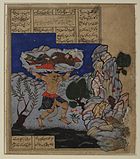 Scene from the Shahnameh: the Akvan Div throws the sleeping Rostam into the sea
Scene from the Shahnameh: the Akvan Div throws the sleeping Rostam into the sea
-
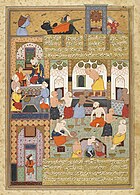 Bath scene
Bath scene
-
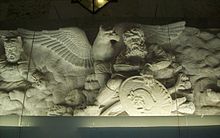 The Simurgh, a mythical bird from the Shahnameh, relief from Ferdowsi's mausoleum
The Simurgh, a mythical bird from the Shahnameh, relief from Ferdowsi's mausoleum
-
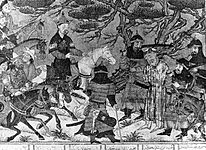 A scene from the Shahnameh depicting the Parthian king Artaban facing the Sassanid king Ardashir I
A scene from the Shahnameh depicting the Parthian king Artaban facing the Sassanid king Ardashir I
Influence
| This section needs additional citations for verification. Please help improve this article by adding citations to reliable sources in this section. Unsourced material may be challenged and removed. Find sources: "Ferdowsi" – news · newspapers · books · scholar · JSTOR (March 2017) (Learn how and when to remove this message) |
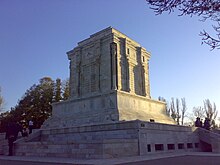
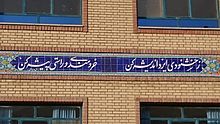

Ferdowsi is one of the undisputed giants of Persian literature. After Ferdowsi's Shahnameh, a number of other works similar in nature surfaced over the centuries within the cultural sphere of the Persian language. Without exception, all such works were based in style and method on Ferdowsi's Shahnameh, but none of them could quite achieve the same degree of fame and popularity as Ferdowsi's masterpiece.
Ferdowsi has a unique place in Persian history because of the strides he made in reviving and regenerating the Persian language and cultural traditions. His works are cited as a crucial component in the persistence of the Persian language, as those works allowed much of the tongue to remain codified and intact. In this respect, Ferdowsi surpasses Nizami, Khayyám, Asadi Tusi and other seminal Persian literary figures in his impact on Persian culture and language. Many modern Iranians see him as the father of the modern Persian language.
Ferdowsi in fact was a motivation behind many future Persian figures. One such notable figure was Rezā Shāh Pahlavi, who established an Academy of Persian Language and Literature, in order to attempt to remove Arabic and French words from the Persian language, replacing them with suitable Persian alternatives. In 1934, Rezā Shāh set up a ceremony in Mashhad, Khorasan, celebrating a thousand years of Persian literature since the time of Ferdowsi, titled "Ferdowsi Millennial Celebration", inviting notable European as well as Iranian scholars. Ferdowsi University of Mashhad is a university established in 1949 that also takes its name from Ferdowsi.
Ferdowsi's influence in the Persian culture is explained by the Encyclopædia Britannica:
- The Persians regard Ferdowsi as the greatest of their poets. For nearly a thousand years they have continued to read and to listen to recitations from his master work, the Shah-nameh, in which the Persian national epic found its final and enduring form. Though written about 1,000 years ago, this work is as intelligible to the average, modern Iranian as the King James Version of the Bible is to a modern English-speaker. The language, based as the poem is on a Dari original, is pure Persian with only the slightest admixture of Arabic.
The library at Wadham College, Oxford University was named the Ferdowsi Library, and contains a specialised Persian section for scholars.
See also
- Alexander the Great in the Shahnameh
- Iranian Studies
- Ferdowsi millennial celebration
- Ferdowsi University of Mashhad
- List of Persian poets and authors
- Persian literature
- Sassanid Empire
- List of mausoleums
- Jerry Clinton (1937–2003), US Ferdowsi scholar
- Ferdowsi (1934 film)
References
- Khaleghi-Motlagh 1999, pp. 514–523 Shahnameh published by Eisenbrauns, Inc. Vol. 6, Pg 341 Vs 657.
- ^ Khaleghi-Motlagh 1999, pp. 514–523.
- ^ Huart/Massé/Ménage: Firdawsī. In: Encyclopaedia of Islam. New Edition. Brill, Leiden. CD-Version (2011)
- "Search Results – Brill Reference". referenceworks.brillonline.com. Retrieved 5 January 2019.
Abū l-Qāsim Firdawsī (320–416/931–1025) was a Persian poet, one of the greatest writers of epic and author of the Shāhnāma ("Book of kings").
- Kia 2016, p. 160.
- Dahlén 2016, p. 249.
- Dabashi 2012, p. 39.
- ^ Davis 2006, p. xviii.
- Frye, R. N. (1975). The Cambridge History of Iran, Volume 4: From the Arab Invasion to the Saljuqs. Cambridge University Press. p. 136. ISBN 0521200938.
- Frye 1975a, p. 200 harvnb error: no target: CITEREFFrye1975a (help)
- "Abu Mansur". Encyclopædia Iranica.
- Frye 1975a, p. 202. sfn error: no target: CITEREFFrye1975a (help)
- Shahbazi, A. Shahpur (26 January 2012). "Mausoleum". Encyclopædia Iranica. Retrieved 1 February 2016.
- Rosenberg 1997, pp. 99–101.
- Shahbazi, A. Shahpur (26 January 2012). "Hajw-nāma". Encyclopædia Iranica. Retrieved 1 February 2016.
- Dahlén 2016, pp. 249–276.
- Ghani 2000, p. 400.
- "Ferdowsi". Encyclopædia Britannica Online. 2007. Retrieved 4 June 2007.
Works cited
- Dabashi, Hamid (2012). The World of Persian Literary Humanism. Harvard University Press. ISBN 978-0-674-06759-2.
- Dahlén, Ashk (2016), "Literary Interest in Zoroastrianism in Tenth-Century Iran: The Case of Daqiqi's Account of Goshtāsp and Zarathustra in the Shāhnāmeh", in Williams, Alan; Stewart, Sarah (eds.), The Zoroastrian Flame: Exploring Religion, History and Tradition, I.B. Tauris, ISBN 9780857728869
- Ferdowski, Abolqasem (2006). Shahnameh: The Persian Book of Kings. Translated by Davis, Dick. Penguin. ISBN 978-0-670-03485-7.
- Frye, Richard N. (1975). The Golden Age of Persia. Weidenfeld.
- Kia, Mehrdad (2016). The Persian Empire: A Historical Encyclopedia [2 volumes]: A Historical Encyclopedia. ABC-CLIO. ISBN 9781610693912.
- Huart, Cl. & Massé, H. (1971). "Firdawsī". In Lewis, B.; Ménage, V. L.; Pellat, Ch. & Schacht, J. (eds.). The Encyclopaedia of Islam, Second Edition. Volume III: H–Iram. Leiden: E. J. Brill. OCLC 495469525.
- Khaleghi-Motlagh, Djalal (1999). "Ferdowsī, Abu'l-Qāsem i. Life". In Yarshater, Ehsan (ed.). Encyclopædia Iranica. Vol. IX/5: Fauna III–Festivals VIII. London and New York: Routledge & Kegan Paul. ISBN 978-0-933273-33-7.
- Rosenberg, Donna (1997). Folklore, Myths, and Legends: A World Perspective. McGraw Hill Professional. ISBN 978-0-8442-5780-8.
- Ghani, Cyrus (2000). Iran and the Rise of Reza Shah: From Qajar Collapse to Pahlavi Power. Bloomsbury Academic. ISBN 978-1-86064-629-4.
General references
- Aghaee, Shirzad (1993). Nam-e kasan va ja'i-ha dar Shahnameh-ye Ferdousi (Personalities and Places in the Shahnameh of Ferdousi. Nyköping, Sweden. ISBN 91-630-1959-0.
{{cite book}}: CS1 maint: location missing publisher (link) - Aghaee, Shirzad (1997). Imazh-ha-ye mehr va mah dar Shahnameh-ye Ferdousi (Sun and Moon in the Shahnameh of Ferdousi. Spånga, Sweden. ISBN 91-630-5369-1.
{{cite book}}: CS1 maint: location missing publisher (link) - Browne, E. G. (1998). A Literary History of Persia. Psychology Press. ISBN 978-0-7007-0406-4.
- Chopra, R. M. (2014). Great Poets of Classical Persian. Kolkata: Sparrow. ISBN 978-81-89140-75-5.
- Mackey, Sandra; Harrop, W. Scott (2008). The Iranians: Persia, Islam and the soul of a nation. University of Michigan. ISBN 978-0-525-94005-0.
- Rypka, Jan (1968). History of Iranian Literature. Reidel. ISBN 90-277-0143-1. OCLC 460598.
- Shahbāzī, ʻA Shāpūr (1991). Ferdowsī: A Critical Biography. Harvard University, Center for Middle Eastern Studies. ISBN 978-0-939214-83-9.
- Sharma, Sunil; Waghmar, Burzine K., eds. (2016). Firdawsii Millennium Indicum: Proceedings of the Shahnama Millenary Seminar, the KR Cama Oriental Institute, Mumbai, 8–9 January, 2011. KR Cama Oriental Institute. pp. 7–18. ISBN 978-93-81324-10-3.
- Wiesehöfer, Josef (2001). Ancient Persia: From 550 BC to 650 AD. I.B. Tauris. ISBN 978-1-4175-2077-0.
External links
- Works by Firdawsi at Project Gutenberg
- Works by or about Ferdowsi at the Internet Archive
- Works by Ferdowsi at LibriVox (public domain audiobooks)

- Khosrow Nāghed, In the Workshop of Thought and Imagination of the Master of Tūs (Dar Kargāh-e Andisheh va Khiāl-e Ostād-e Tūs), in Persian, Radio Zamāneh, 5 August 2008.
- Ferdowsi: Poems Ferdowsi's poems in English
- Iraj Bashiri, The Shahname of Firdowsi
- Ferdowsi Museum photos
- Ferdowsi Tomb photos
- A king's book of kings: the Shah-nameh of Shah Tahmasp, an exhibition catalog from The Metropolitan Museum of Art (fully available online as PDF)
- Ferdowsi Quotes Archived 17 April 2015 at the Wayback Machine
| Ferdowsi | ||
|---|---|---|
| Books |  | |
| Places | ||
| Lands | ||
| Organizations | ||
| People | ||
| Memorial | ||
| Depictions in others' works | ||
| Related | ||
- Ferdowsi
- 11th-century Persian-language writers
- Poets from the Ghaznavid Empire
- Poets from the Samanid Empire
- Epic poets
- Mythopoeic writers
- Dehqans
- Iranian folklore
- People from Khorasan
- People from Tus, Iran
- Shahnameh
- 10th-century Persian-language writers
- 10th-century Persian-language poets
- 11th-century Persian-language poets
- 10th-century births
- 11th-century deaths


